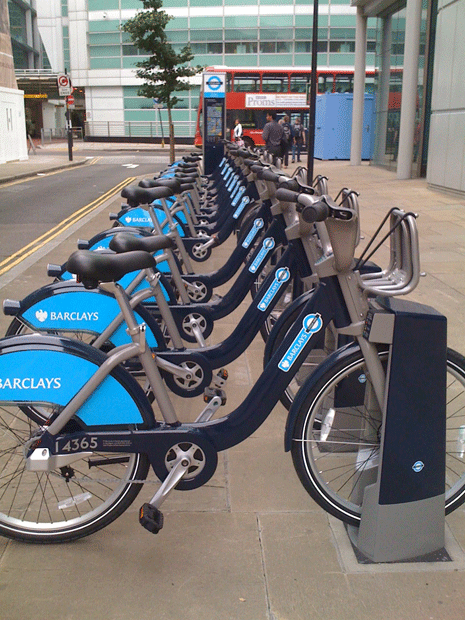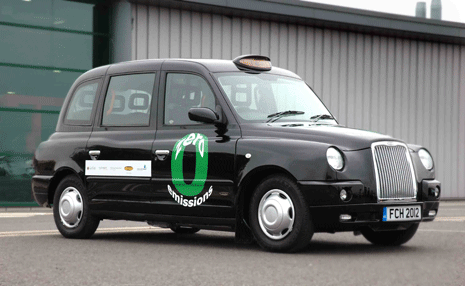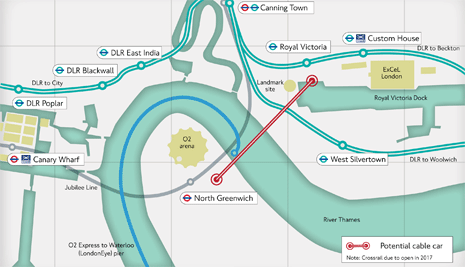
I was in London on Friday and stumbled across the Barclays Cycle Hire Scheme whilst walking from Euston Square towards Covent Garden. Not living in the capital, this line-up up of about 20 or so identical bicycles took me quite by surprise and I immediately took a photo (above). When I googled it later I soon realised that it has been in discussion for quite some time but Friday was the official launch date. According to Transport for London, more than 14,250 journeys were made this weekend alone and over 21,000 members have now signed up to join the scheme. I think it’s a great idea – get people out of the sweaty tubes and into the open air (although how fresh the air is in the centre of London is negligible).
The scheme is intended for short journeys – essentially, help yourself to a bike from a docking station, ride it where you like, then return it to another station ready for the next person. Although the weekend posed a few teething problems in terms of software and technical issues, ultimately it was a success and London’s Mayor, Boris Johnson, had this to say: “Just three days into our cycle hire scheme we are seeing Londoners embracing the freedom of pedal power and are signing up in their droves. With every new day, these gleaming machines are transforming our streets and are putting us well on our way to becoming the best big cycling city in the world.” Once the scheme is fully installed, 6,000 cycles will be available at 400 locations across Zone 1.

Other green transport initiatives recently launched in the capital include the New Bus for London. Based on the much-loved red Routemaster, this new design will use the greenest hybrid technology making it 15 per cent more fuel efficient than existing hybrid buses. Using lightweight materials and incorporating interesting features, the design certainly looks rather futuristic. In fact, Wrightbus and Transport for London have been working with renowned design agency Heatherwick Studio as a collaborative design partner taking the lead on the styling of the bus to support Wrightbus in the design and development process. Wrightbus engineers are currently working on a static mock-up of the bus to be complete later this year with the first prototype to be delivered late next year, in time for them to enter service from early 2012. As Johnson said when the design was unveiled, “This iconic new part of our transport system is not only beautiful, but also has a green heart beating beneath its stylish, swooshing exterior.”
However, in 2012 if you don’t want to take public transport you can always opt for a fuel cell hybrid London taxi. Unveiled at London’s City Hall in June, this taxi may look like an iconic London black cab, but is in fact powered by an Intelligent Energy hydrogen fuel cell system hybridised with lithium polymer batteries. Lotus Engineering, who was also involved in its development, packaged the full propulsion system including the fuel cell engine and designed control systems to optimise performance of both the fuel cells and electric drive systems. The fuel cell system has been integrated into the most recent TX4, a purpose built taxicab hackney-carriage manufactured by LTI, and fits into the vehicle without intrusion into its internal or luggage space.

Capable of achieving a top speed of over 80mph, the taxi has a range of more than 250 miles on a full tank of hydrogen, refuels in about 5 minutes and produces no emissions other than water vapour. “The Fuel Cell Black Cab is a hackney-carriage fit for the 21st Century and its ever larger urban centres, where the reclamation of good air quality matters hugely to all of us. The LTI TX4 is an internationally recognised and iconic symbol of London, and to put an entirely new fuel cell hybrid electric zero emissions ‘engine’ into the existing vehicle design in such a short amount of time and still deliver performance, refuelling speeds and range, is a fantastic achievement for all the companies involved,” explained Dr Henri Winand, CEO at Intelligent Energy, at the launch. “We now look towards the introduction of the first fleet of these vehicles into London for the 2012 Olympics.”
Talking of transport for the London Olympics, I was rather intrigued to recently find out that a cable car is planned for the games. The proposals, being developed by Transport for London, would provide a privately funded, fully accessible cable car for cyclists and pedestrians who want to cross the river between the two major Olympic venues of Greenwich Peninsula (O2 arena) and Royal Docks (ExCel) (map below). At a height of 50 metres, a crossing could take place every 30 seconds and carry up to 2,500 passengers per hour. However, before we all get excited, it’s still in the early stages of development with detailed work on the design, operating hours and fares structure still to be carried out.
Well, I for one hope it takes off (mind the pun) and I’m also looking forward to trying out all of these other green transport solutions planned for the capital in the very near future.







